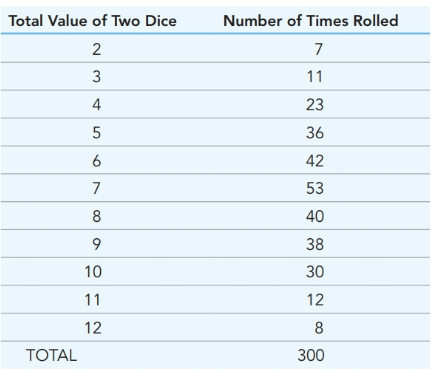
Concept explainers
For a single dice roll, there is a

The student tells you that her results fail to prove that random chance is the explanation for the outcome of this experiment. Is she correct or incorrect? Support your answer.
Want to see the full answer?
Check out a sample textbook solution
Chapter 2 Solutions
Genetic Analysis: An Integrated Approach (2nd Edition)
- Using the information and data from the 2 photos, answer the last question on the bottom of the second page. Please answer in detail and accurately. The question asks: “Did your results from the coin tosses support your prediction from the Punnett Square? Specify the data you used.”arrow_forwardWhat is the mis-application of probability or the simple but incorrect solution?arrow_forwardExplain as you would to a 12th grader why, using Punnett squares the probability an offsprint being XX or XY is approximately 50%.arrow_forward
- (1 question with multiple steps please answer them all) In your own words, describe the difference between continuous and discrete data sets. What is the difference between the independent and dependent variable? How do you determine which goes on which axis on your graph? What are the four types of correlation? How do they differ from one another? In your own words, explain the difference between correlation and causation.arrow_forwardCould you please highlight the correct answer. and explain itarrow_forwardIn a large population of mice, 0.58 have the recessive genetic condition rsiancer (fictional). Assume the Hardy-Weinberg distribution. What fraction of mice are carriers? Giver your answer with two digits parts the decimal point.arrow_forward
- What is the EXPECTED # of students who would be heterozygous (+/-) ? There were 15 students who examined their ALU PV92 genotype status. That semester we determined that there were 7 students who were -/- 4 students who were +/- 4 students who were +/+ Group of answer choices 2.4 4 5 7.2arrow_forwardThe following is a possible genotype from an unnamed organism: e*/e" ; b*x*/b"x ; y'ly; w*k*/w*k* The genotype is the same for the first 4 question of this quiz. of Which gene(s) has(have) a heterozygous genotype? Select all that apply. -1 for each incorrect answer to a total of zero. cross out a. k cross out O b. b cross out O c. e cross out O d. X cross out O e. cross out Of. yarrow_forwardThe height of a shrubbery decreases as we ascend (climb) a mountain. This variation in height is most likely due to underlying changes in genotype. True Falsearrow_forward
- page - Columbus State Uni X content/2622738/viewContent/50155728/View + Calculating the Value of Chi-Square Once you've defined the null hypothesis (and know what you're testing!), you can finally calculate the chi-square value based on your observed data and the expected distribution. There are many statistical software packages and free web-based applications that will automate the calculation for you, but it's important to understand the calculation to understand the meaning of the calculated value. Here, we'll walk through it using a calculation table. This is Mendel's historic data for the F2 generation of monohybrid cross for flower color. Recall that he expected to see in the F2 generation a ratio of 3 purple : 1 white. Chi-square calculation for data from a monohybrid cross with an expected 3 purple : 1 white ratio. Outcomes Observed (0) Expected (E) O-E (0-E)2 (O-E)²/E Purple White Totals 705 224 929 X²= The first step is to calculate the expected (E) values for purple and…arrow_forwardIf there is no difference between what is observed and what is expected, your chi-square value will be ________ . Group of answer choices impossible to determine 1 -1 0arrow_forwardThe following is a possible genotype from an unnamed organism: e*/e ; b*x*/b°x; yly ; w*k*/w°k* The genotype is the same for the first 4 question of this quiz. How many wild-type are shown among all the genes shown in the genotype? Type your answer as the number, not the word (eg: 50). Answer:arrow_forward
 Human Biology (MindTap Course List)BiologyISBN:9781305112100Author:Cecie Starr, Beverly McMillanPublisher:Cengage Learning
Human Biology (MindTap Course List)BiologyISBN:9781305112100Author:Cecie Starr, Beverly McMillanPublisher:Cengage Learning



